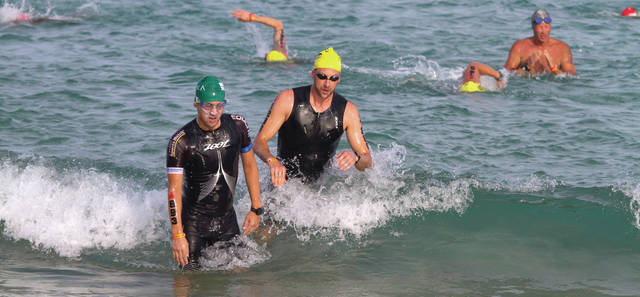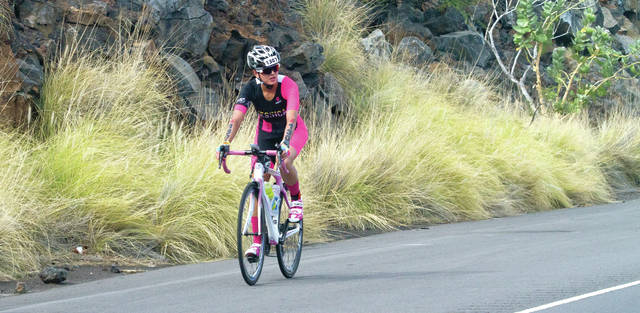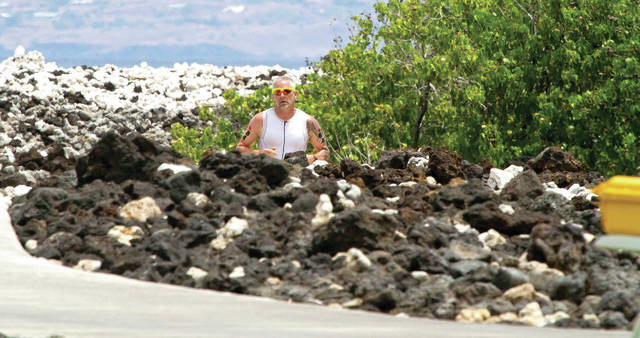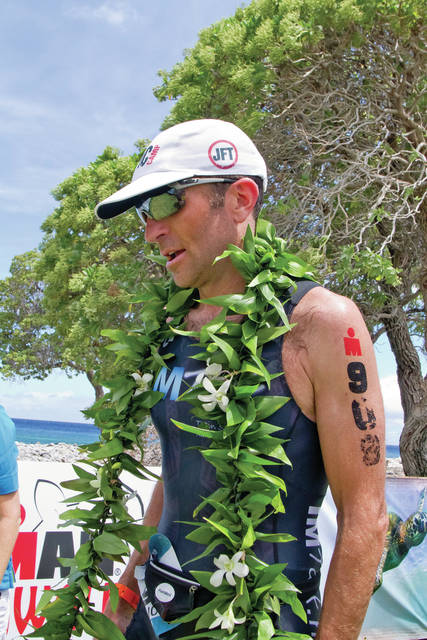Age group athletes provide elite competition at Ironman 70.3 Hawaii:
KOHALA COAST — So much in sports is about not looking too far ahead, while also being careful not to get caught up on what’s in the rearview mirror.
That advice certainly rang true at Ironman 70.3 Hawaii on Saturday morning as wave upon wave of age-group athletes splashed into the waters at Hapuna, starting a trek destined to end at the Fairmont Orchid later in the afternoon.
You could have easily got lost in the shuffle of it all.
An estimated 1,600 triathletes took on the 1.2-mile swim, 56-mile bike and 13.1-mile run course at the event known fondly locally as Honu, battling through some hot and windy conditions at the race touted as one of the toughest on the half-Ironman circuit.
On the line were 50 qualifying spots for the Ironman 70.3 World Championship in Chattanooga, Tennessee, going to the top finishers within each age group.
As morning transitioned to early afternoon, John Newsom was the first athlete into the finishing chute, breaking the tape at Honu Pointe in 4 hours, 23 minutes and 34 seconds, being awarded a celebratory maile lei for the victory.
“It’s what I hoped for today,” Newsom said shortly after finishing. “I got out to a pretty good lead, so I didn’t have to completely empty the tank on the run. I can’t complain. It’s a great feeling.”
Newsom — a triathlon coach from New Zealand — handily won his age group (male 40-44), but still had to wait to celebrate the overall victory with Levi Hauwert (male 30-34) scorching through the run course.
With no elite wave and a new rolling swim start within the age-group waves — signaled by a buzzer every five seconds — final position wasn’t necessarily determined by who crossed the finish line first.
“Some of these young guns could still have a chance to catch me,” Newsom said, keeping a keen eye on the finish line.
But this time, Newsom didn’t have to turn over the lei.
With a strong run, Hauwert overcame what he called a “miserable” day on the bike, clocking a time of 4:25:25, which gave him the win in his age group, but relegated him to second overall, behind Newsom.
“On the bike, guys were just riding away from me like I was standing still,” Hauwert said. “I was getting slower and slower and was starting to think my day was over.”
But then the Aussie hit the golf course grounds running, and started to get his groove back, managing to pick off almost all his competition before hitting the second lap.
“I just put my head down and stuck to my game plan,” Hauwert said. “It just shows, never give up. Keep going until it’s over.”
Rounding out the overall male podium was California’s Wesley Schiller (04:26:36).
Wee bolsters retirement resume
This whole retirement thing is working out pretty well for Bree Wee.
Racing with a clear head and a focus on just having fun, Wee left no doubt in her victory at Honu.
The hometown favorite — who won the race in 2011 as a pro — finished nearly six minutes ahead of the rest of the female field, cruising to the overall title with a time of 04:58:52.
“I feel awesome,” Wee said. “It’s always nice to win in your backyard.”
Wee retired from professional triathlon last year, but still finds herself at the front of the pack on most days. What made this one a little more memorable was that Wee was — well — tired.
“This one is special. I was very undertrained, so it took literally every ounce of effort I had,” said Wee, now a teacher at Kahakai Elementary School. “It’s way more rewarding.”
Shannon Proffit (5:05:05) was the second overall female finisher, followed by Oahu’s Lectie Altman (5:07:10).
Defending home turf
David Wild (04:30:45) finished as the top local male, something he has made a habit of in local races since arriving on the island in 2014.
But make no mistake — it’s not a duty he takes lightly.
“I don’t want people to think they are going to come here for their vacation race and it will be an easy win,” Wild said with a grin. “There are people that live here that want to defend this turf.”
Wild was just having a good time, as is apparent most of the time when he is racing. The unofficial ambassador for out-of-towners at the event has made countless friends with the visiting racers.
“In the end, none of us are pros out here. We are doing this for fun,” he said. “If we are not doing it for fun, then maybe we need to question ourselves a little.”
Wild finished fifth overall and third in his 30-34 age group. He wasn’t worried about garnering a spot at the 70.3 Worlds in Chattanooga — or the Noogz, as he refers to it. He already had his spot locked up from a previous race and will be heading to the Volunteer State in September to represent the Big Island.
Other than Wee, Kona’s Dan Gampon was the only local age group winner in the field, finishing first in the 18-24 division with a time of 04:55:47.
Relaying history
Back in 2004, Tim Marr won the first Ironman 70.3 Hawaii, forever linking his name with the race.
With a little help from some friends, Marr managed to make a little more history with another first at the race.
Marr, along with Kona’s Penn Henderson and New Zealand Honu rookie Jesse Tuke, took home the inaugural relay title at the event, turning in a combined time of 04:20:01.
“For me, it’s pretty cool to win the first race, and then the first relay,” Marr said. “I’ve watched this change from more of a local event in that first year, to an international event with some of the best professional triathletes in the world coming here. Now, it has gone the other way, catering to the age group athletes, but it’s still a huge hit.”
Marr did the swim (26:23), Henderson the bike (2:15:14) and Tuke clinched the victory on the run (1:33:48) for Team Bioastin.
Both Marr and Henderson’s times were the best of the day — regardless of division. Tuke had the second fastest run, behind only Hauwert.
But it wasn’t as easy as it looked. The team’s first runner dropped out on Monday, leaving Henderson and Marr scrambling for a quick fill-in. On Thursday, Tuke, a friend of Marr who was in town for business, signed on to join the squad to run his first half-marathon.
It was quite the debut for the Kiwi, who’s specialty is the 800-meter.
“What a place to do it — running on golf courses surrounded by lava fields,” Tuke said. “I would have struggled a little more if it wasn’t on a golf course. I was just out there imagining I had a 7-iron in my hand.”
A confident post-race Marr never doubted Tuke.
“The moment I was 100 percent was when he told me he had never run a half-marathon before,” Marr said with a laugh. “I knew he could run.”
The trio hopes the relay sticks around at Honu, not only to defend their title, but because it builds a unique feeling of camaraderie not commonly found in the heavily-individual sport.
“You are really trying not to let your teammates down and really anything can happen out there. When your part is over, it’s a relief,” Henderson said. “On the bike, I always had these guys in the back of my mind, and it helped me keep going even though my legs were burning.”
Rolling, rolling, rolling
For those who were still half-asleep on the beach for the swim start, a steady beep served a secondary alarm clock at Hapuna.
The noise was the sound of Ironman’s new rolling swim start, which sent four athletes at a time from the beach into the water every five seconds.
The system had participants self-seed themselves within their age groups according to their predicted swim time. It is meant to increase safety, reduce anxiety and allow athletes to swim at their own pace.
“I’m usually always crawling over some people in the swim, but this time, I felt like I crawled over a few less people,” Wild said.
While most athletes asked about the system said they would have preferred a mass start, the trickle, rather than the surge out of the gate also had the potential to spread out packs and reduce drafting on the bike — a problem many see as a large issue in the sport.
“The worst thing in this sport is drafting, and from what I saw, it worked pretty well at breaking that up,” Hauwert said.
The rolling start also eliminates — to a degree — head-to-head competition. That can be either a blessing or a curse, depending on racing styles.
“It really helps you stick with the cliché of race your own race,” Wild said. “When you don’t know or worry about everyone else’s placement, it forces you to stick by that philosophy.”








